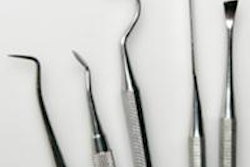
Endosseous dental implants, also known as blade-form implants, could get a boost in interest from the dental community as the U.S. Food and Drug Administration (FDA) moves forward with efforts to reclassify the implants as lower risk.
The FDA Medical Devices Advisory Committee's Dental Products Panel met on July 18 to consider reclassifying the implants from class III to class II, first proposed in January. Class II medical devices are of "medium risk," while class III is a "high-risk" medical device that is also highly regulated.
"The outcome of the panel meeting was that the panelists concluded the device should be regulated as class II (Special Controls)," Susan Laine, part of the FDA's Office of Media Affairs, wrote in an email to DrBicuspid.com. "The next step is that FDA will consider all panelists' comments from the meeting and write a final order for this device."
While the panelists felt certain health risks were adequately described in the previous designation, it questioned the severity of others, specifically, "the inclusion of immune response and potential motor nerve damage as risks to health for this particular device," according to a summary issued by the Department of Health and Human Services (HHS).
In preparing for the meeting, the panel received responses from one clinician and one manufacturer of blade-form implants, both of which urged a reclassification. The panel also included an Epidemiology Literature Review Team and a Manufacturer and User Facility Device Experience (MAUDE) Search Team. In addition, PubMed, Embase, and Web of Science studies were searched using blade-form implant keywords for evidence of their reliability and risks involved with placement.
Long-term safety
During the July 18 presentation, the evidence for long-term safety and effectiveness of blade-form implants was of particular interest. Of 148 results, 10 studies -- nine observational and one randomized controlled trial -- were subjected to a qualitative synthesis, and the panel was presented with a broad look at their findings. The analysis revealed that, at five years, survivability ranged from 86% to 100%.
In the observational studies, the success rates were more than 90% and the summary of the studies was glowing: "A long-term 100% device survivability was widely reported. Available evidence suggests that the device is effective and has a satisfactory long-term safety profile."
The panel was also asked to address the completeness of health risks related to the placement of blade-form implants covered by the proposed reclassification. In the literature summary, bone loss and deterioration were the two most commonly reported adverse events.
In that vein, the panel also commented on how to select patients that are suitable candidates for blade-form implants, discussing factors such as smoking, radiation or chemotherapy treatment, diabetes, poor oral hygiene, and certain prescription drugs. They agreed that selection criteria or recommendations discussed as part of the risks to health should be included along with contraindications and surgical protocol information in the labeling of blade-form implant products, the summary explained.
During the meeting, the panel heard proposed special controls:
- Design characteristics: These had to be consistent with the intended use of the device in terms of geometry and material composition.
- Mechanical testing: Fatigue and endurance limits must be tested in simulated physiological conditions under compressive and shear loads.
- Corrosion testing the ability of the metal alloys used in the implants had to pass muster for corrosion rates.
- Magnetic resonance environment compatibility.
While the panel found the controls to be reasonable, it concluded that "general controls alone are not sufficient due to the identified risks to health," according to the meeting summary. "However, special controls, in combination with the general controls, can be sufficient" with the inclusion of the panelists' suggestions.
With that, they agreed that the class II (Special Controls) designation is warranted. All that is left is for the final order to be published. However, at this time, there is no set time frame for publishing the final order, according to Laine.



















